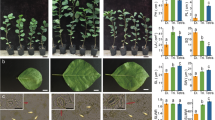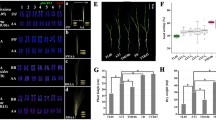Abstract
Polyploidy and haploid are widely employed in the studies of genetics and evolution, and great progress has been made in these fields, inspiring the enthusiasm of scientists to explore the ploidy effects in gene expression. In this paper, we review the gene expression and its regulation in polyploids, especially in autopolyploids. We summarize some limitations in previous reports on polyploidy gene expression and its regulation, especially the limitations in the research materials. We propose an idea to create homologous ploidy series with twin-seedlings and to employ high-throughput techniques to investigate the polyploidy transcriptome and its regulation.
Similar content being viewed by others
References
Wolfe K H. Yesterday’s polyploids and the mystery of diploidization. Nat Rev Genet, 2001, 2(5): 333–341, 11331899, 10.1038/35072009, 1:CAS:528:DC%2BD3MXjtlGjs7g%3D
Cui L, Wall P K, Leebens-Mack J H, et al. Widespread genome duplications throughout the history of flowering plants. Genome Res, 2006, 16(6): 738–749, 16702410, 10.1101/gr.4825606, 1:CAS:528:DC%2BD28XlvVeiurY%3D
Soltis P S. Ancient and recent polyploidy in angiosperms. New Phytol, 2005, 166(1): 58, 10.1111/j.1469-8137.2005.01379.x
Leitch I L, Bennett M D. Polyploidy in angiosperms. Trends Plant Sci, 1997, 2: 470–476, 10.1016/S1360-1385(97)01154-0
Paterson A H, Bowers J E. Chapman B A. Ancient polyploidization predating divergence of the cereals, and its consequences for comparative genomics. Proc Natl Acad Sci USA, 2004, 101(26): 9903–9908, 15161969, 10.1073/pnas.0307901101, 1:CAS:528:DC%2BD2cXlvVahtbY%3D
Paterson A H, Bowers J E, Peterson D Q et al. Structure and evolution of cereal genomes. CurrOpin Genet Dev, 2003,13(6): 644–650, 10.1016/j.gde.2003.10.002, 1:CAS:528:DC%2BD3sXpt1Snsbs%3D
Yu J, Wang J, Lin W, et al. The Genomes of Oryza sativa: A history of duplications. PLoS Biol, 2005, 3(2): e38, 15685292, 10.1371/journal.pbio.0030038
Schranz M E, Osborn T C. De novo variation in life-history traits and responses to growth conditions of resynthesized polyploid Brassica napus (Brassicaceae). Am J Botany, 1991, 91(2): 174–183, 10.3732/ajb.91.2.174
Chen C, Xiao H, Zhang W, et al. Adapting rice anther culture to gene transformation and RNA interference. Sci China Ser C-Life Sci, 2006, 49(5): 414–428, 10.1007/s11427-006-2013-2, 1:CAS:528:DC%2BD2sXktlWluw%3D%3D
Cai D T, Chen J G, Chen D L, et al. The breeding of two polyploid rice lines with the characteristic of polyploid meiosis stability. Sci China Ser C-Life Sci, 2007, 50(3): 356–366, 10.1007/s11427-007-0049-6, 1:CAS:528:DC%2BD2sXosF2hsrs%3D
Galitski T, Saldanha A J, Styles C A, et al. Ploidy regulation of gene expression. Science, 1999, 285(5425): 251–254, 10398601, 10.1126/science.285.5425.251, 1:CAS:528:DyaK1MXks1Sjtbc%3D
Storchova Z, Breneman A, Cande J, et al. Genome-wide genetic analysis of polyploidy in yeast. Nature, 2006, 443(7111): 541–547, 17024086, 10.1038/nature05178, 1:CAS:528:DC%2BD28XhtVCiu73M
Guo M, Davis D. Birchler J A. Dosage effects on gene expression in a maize ploidy series. Genetics, 1996, 142(4): 1349–1355, 8846910, 1:CAS:528:DyaK28XivVGjuro%3D
Stupar R M, Bhaskar P B, Yandell B S, et al. Phenotypic and transcriptomic changes associated with potato autopolyploidization. Genetics, 2007, 176(4): 2055–2067, 17565939, 10.1534/genetics.107.074286, 1:CAS:528:DC%2BD2sXhtFGnu7fM
Albertin W, Brabant P, Catrice O, et al. Autopolyploidy in cabbage (Brassica oleracea L.) does not alter significantly the proteomes of green tissues. Proteomics, 2005, 5(8): 2131–2139, 15852348, 10.1002/pmic.200401092, 1:CAS:528:DC%2BD2MXltVSjsrc%3D
Zhang H, Peng H, Li Y, et al. Patterns of DNA cytosine methylation between haploids and corresponding diploids in rice. Chin Sci Bull, 2006, 51(14): 1721–1728, 10.1007/s11434-006-2048-6, 1:CAS:528:DC%2BD28XmvFSgtbY%3D
Adams K L. Evolution of duplicate gene expression in polyploid and hybrid plants. J Heredity, 2007, 98(2): 136,10.1093/jhered/esl061, 1:CAS:528:DC%2BD2sXmvF2jsr8%3D
Pontes O, Neves N, Silva M, et al. Chromosomal locus rearrangements are a rapid response to formation of the allotetraploid Arabidopsis suecica genome. Proc Natl Acad Sci USA, 2004, 101(52): 18240–18245, 15604143, 10.1073/pnas.0407258102, 1:CAS:528:DC%2BD2MXjsl2kuw%3D%3D
Udall J A, Wendel J F. Polyploidy and crop improvement. Crop Sci, 2006, 46(Suppll):S3–14
Madlung A, Masuelli R W, Watson B, et al. Remodeling of DNA methylation and phenotypic and transcriptional changes in synthetic Arabidopsis allotetraploids. Plant Physiol, 2002, 129(2): 733–746, 12068115, 10.1104/pp.003095, 1:CAS:528:DC%2BD38XkvV2jt7w%3D
Lukens L N, Pires J C, Leon E, et al. Patterns of sequence loss and cytosine methylation within a population of newly resynthesized Brassica napus allopolyploids. Plant Physiol, 2006, 140(1): 336–34816377753, 10.1104/pp.105.066308, 1:CAS:528:DC%2BD28XhtVCgtrc%3D
Chen Z J, Ni Z. Mechanisms of genomic rearrangements and gene expression changes in plant polyploids. Bioessays, 2006, 28(3): 240–252, 16479580, 10.1002/bies.20374
Wang J, Tian L, Lee H S, et al. Genomewide nonadditive gene regulation in Arabidopsis allotetraploids. Genetics, 2006, 172(1): 507–517, 16172500, 10.1534/genetics.105.047894, 1:CAS:528:DC%2BD28XhvV2jtrk%3D
Wang J, Tian L, Madlung A, et al. Stochastic and epigenetic changes of gene expression in Arabidopsis polyploids. Genetics, 2004, 167(4): 1961–1973, 15342533, 10.1534/genetics.104.027896, 1:CAS:528:DC%2BD2cXos1egtrc%3D
Adams K L, Percifield R. Wendel J F. Organ-specific silencing of duplicated genes in a newly synthesized cotton allotetraploid. Genetics, 2004, 168(4): 2217–2226, 15371349, 10.1534/genetics.104.033522, 1:CAS:528:DC%2BD2MXhtVyjtr8%3D
Hegarty M J, Jones J M, Wilson I D, et al. Development of anonymous cDNA microarrays to study changes to the Senecio floral transcriptome during hybrid speciation. Mol Ecol, 2005, 14(8): 2493–2510, 15969730, 10.1111/j.1365-294x.2005.02608.x, 1:CAS:528:DC%2BD2MXmvF2qsbk%3D
Albertin W, Balliau T, Brabant P, et al. Numerous and rapid nonstochastic modifications of gene products in newly synthesized Brassica napus allotetraploids. Genetics, 2006, 173(2): 1101–1113, 16624896, 10.1534/genetics.106.057554, 1:CAS:528:DC%2BD28Xns12qt7w%3D
Kashkush K, Feldman M, Levy A A. Gene loss, silencing and activation in a newly synthesized wheat allotetraploid. Genetics, 2002, 160(4): 1651–1659, 11973318, 1:CAS:528:DC%2BD38XktFahtro%3D
He P, Friebe B R, Gill B S, et al. Allopolyploidy alters gene expression in the highly stable hexaploid wheat. Plant Mol Biol, 2003, 52(2): 401–414, 12856945, 10.1023/A:1023965400532, 1:CAS:528:DC%2BD3sXktFSmu74%3D
Lynch M, Force A. The probability of duplicate gene preservation by subfunctionalization. Genetics, 2000, 154(1): 459–473, 10629003, 1:CAS:528:DC%2BD3cXms1KhsA%3D%3D
Adams K L, Cronn R, Percifield R, et al. Genes duplicated by polyploidy show unequal contributions to the transcriptome and organ-specific reciprocal silencing. Proc Natl Acad Sci USA, 2003, 100(8): 4649–4654, 12665616, 10.1073/pnas.0630618100, 1:CAS:528:DC%2BD3sXjt12nsrc%3D
Adams K L, Wendel J F. Polyploidy and genome evolution in plants. Curr Opin Plant Biol, 2005, 8(2): 135–141, 15752992, 10.1016/j.pbi.2005.01.001, 1:CAS:528:DC%2BD2MXitVCntLY%3D
Adams K L, Wendel J F. Novel patterns of gene expression in polyploid plants. Trends Genet, 2005, 21(10): 539–543, 16098633, 10.1016/j.tig.2005.07.009, 1:CAS:528:DC%2BD2MXhtVWisbzJ
McClintock B. The significance of responses of the genome to challenge. Science, 1984, 226(4676): 792–801,15739260, 10.1126/science.15739260, 1:STN:280:DC%2BD2M7gvV2juw%3D%3D
Guo H, Ecker J R. The ethylene signaling pathway: New insights. Curr Opin Plant Biol, 2004, 7(1): 40–49, 14732440, 10.1016/j.pbi.2003.11.011, 1:CAS:528:DC%2BD2cXltFWqtg%3D%3D
Wendel J F. Genome evolution in polyploids. Plant Mol Biol, 2000, 42(1): 225–249, 10688139, 10.1023/A:1006392424384, 1:CAS:528:DC%2BD3cXht1Grsrk%3D
Liu B, Wendel J F. Epigenetic phenomena and the evolution of plant allopolyploids. Mol Phylogenet Evol, 2003, 29(3): 365–379, 14615180, 10.1016/S1055-7903(03)00213-6, 1:CAS:528:DC%2BD3sXovVWntb0%3D
Hegarty M J, Barker G L, Wilson I D, et al. Transcriptome shock after interspecific hybridization in Senecio is ameliorated by genome duplication. Curr Biol, 2006, 16(16): 1652–1659, 16920628, 10.1016/j.cub.2006.06.071, 1:CAS:528:DC%2BD28XosVOhtrs%3D
Auger D L, Gray A D, Ream T S, et al. Nonadditive gene expression in diploid and triploid hybrids of maize. Genetics, 2005, 169(1): 389–397, 15489529, 10.1534/genetics.104.032987, 1:CAS:528:DC%2BD2MXit1yhsLw%3D
Osborn T C, Pires J C, Birchler J A, et al. Understanding mechanisms of novel gene expression in polyploids. Trends Genet, 2003, 19(3): 141–147, 12615008, 10.1016/S0168-9525(03)00015-5, 1:CAS:528:DC%2BD3sXhsVaisrY%3D
Guo M, Birchler J A. Trans-acting dosage effects on the expression of model gene systems in maize aneuploids. Science, 1994, 266(5193): 1999–2002,17836517, 10.1126/science.266.5193.1999, 1:CAS:528:DyaK2MXisl2lu70%3D
Kashkush K, Feldman M. Levy A A. Transcriptional activation of retrotransposons alters the expression of adjacent genes in wheat. Nat Genet, 2003, 33(1): 102–106,12483211, 10.1038/ng1063, 1:CAS:528:DC%2BD38XpvVeqs7s%3D
Yamada K, Lim J, Dale J M, et al. Empirical analysis of transcriptional activity in the Arabidopsis genome. Science, 2003, 302(5646): 842846,10.1126/science.1088305
Lee H S, Chen Z J. Proteincoding genes are epigenetically regulated in Arabidopsis polyploids. Proc Natl Acad Sci USA, 2001, 98(12): 6753–6758, 11371624, 10.1073/pnas.121064698, 1:CAS:528:DC%2BD3MXksVOku7w%3D
Comai L, Tyagi A P, Winter K, et al. Phenotypic instability and rapid gene silencing in newly formed Arabidopsis allotetraploids. Plant Cell, 2000, 12(9): 1551–1568, 11006331, 10.1105/tpc.12.9.1551, 1:CAS:528:DC%2BD3cXnsVylsbc%3D
Zhang X, Yazaki J, Sundaresan A, et al. Genome-wide high-resolution mapping and functional analysis of DNA methylation in Arabidopsis. Cell, 2006, 126(6): 1189–1201,16949657, 10.1016/j.cell.2006.08.003, 1:CAS:528:DC%2BD28XhtVCnsrvP
Tate J A, Soltis D E, Soltis P S. Polyploidy in Plants, in the Evolution of the Genome. New York: Academic Press, 2004
Otto S P, Whitton J. Polyploid incidence and evolution. Annu Rev Genet, 2000, 34:401437, 10.1146/annurev.genet.34.1.401
Baumel A, Ainouche M L. Levasseur J E. Molecular investigations in populations of Spartina anglica C.E. Hubbard (Poaceae) invading coastal Brittany (France). Mol Ecol, 2001, 10(7): 1689–1701, 11472537, 10.1046/j.1365-294X.2001.01299.x, 1:CAS:528:DC%2BD3MXlvVyns7w%3D
Cook L M, Soltis P S. Mating systems of diploid and allotetraploid populations of tragopogon (Asteraceae). I. Natural populations. Heredity, 1999, 82(Pt 3): 237–244, 10336697, 10.1038/sj.hdy.6884620
Abbott R J, Lowe A J. Origins, establishment and evolution of new polyploid species: Senecio cambrensis and S. eboracensis in the British Isles. Biol J Lonn Soc, 2004, 82: 467–474, 10.1111/j.1095-8312.2004.00333.x
Wendel J F, Doyle J J, eds. Phylogenetic incongruence: Window into genome history and molecular evolution. In: Soltis D E, Soltis P S, Doyle J J, eds. Molecular Systematics of Plants. II. Boston: Kluwer Academic Pub, 1998. 265–296
Han F P, Liu Z L, Tan M, et al. Mobilized retrotransposon Tos 17 of rice by alien DNA introgression transposes into genes and causes structural and methylation alterations of a flanking genomic region. Heredity, 2004, 141(3): 243–251, 10.1111/j.1601-5223.2004.01808.x, 1:STN:280:DC%2BD2M%2FnsVehtg%3D%3D
Cheng C, Daigen M, Hirochika H. Epigenetic regulation of the rice retrotransposon Tos 17. Mol Genet Genomics, 2006, 276(4): 378–390, 16821043, 10.1007/s00438-006-0141-9, 1:CAS:528:DC%2BD28XovF2ltbg%3D
Guo M, Birchler J A. Trans-acting dosage effects on the expression of model gene systems in maize aneuploids. Science, 1994, 266(5193): 1999,17836517, 10.1126/science.266.5193.1999, 1:CAS:528:DyaK2MXisl2lu70%3D
Zilberman D, Henikoff S. Genome-wide analysis of DNA methylation patterns. Development, 2007, 134: 3959–3965, 17928417, 10.1242/dev.001131, 1:CAS:528:DC%2BD1cXmvVI%3D
Peng H, Zhang H Y, Li Y, et al. Natural homologous triploidization and DNA methylation of twin-seedling rice SARII-628. Chin J Rice Sci, 2006,20(5): 469–474, 1:CAS:528:DC%2BD2sXitlOrug%3D%3D
Zilberman D, Gehring M, Tran R K, et al. Genome-wide analysis of Arabidopsis thaliana DNA methylation uncovers an interdependence between methylation and transcription. Nat Genet, 2007, 39:61–69, 17128275, 10.1038/ng1929, 1:CAS:528:DC%2BD28XhtlGktLvJ
Margulies M, Egholm M, Altman W E, et al. Genome sequencing in microfabricated high-density picolitre reactors. Nature, 2005, 437(7057): 376–380, 16056220, 1:CAS:528:DC%2BD2MXpvFOrt7s%3D
Ju J, Kim D H, Bi L, et al. Four-color DNA sequencing by synthesis using cleavable fluorescent nucleotide reversible terminators. Proc NatlAcad Sci USA, 2006, 103(52): 19635–19640, 10.1073/pnas.0609513103, 1:CAS:528:DC%2BD2sXjtVSlsg%3D%3D
Bentley D R. Whole-genome re-sequencing. Curr Opin Genet Dev, 2006, 16: 545–552, 17055251, 10.1016/j.gde.2006.10.009, 1:CAS:528:DC%2BD28Xht1Cmt7jN
Barski A, Cuddapah S, Cui K, et al. High-resolution profiling of his-tone methylations in the human genome. Cell, 2007, 129(4): 823–837,17512414, 10.1016/j.cell.2007.05.009, 1:CAS:528:DC%2BD2sXmtFKjsro%3D
Author information
Authors and Affiliations
Corresponding author
Additional information
Contributed equally to this work
Supported by the National Natural Science Foundation of China (Grant No. 30771157) and the Changjiang Scholars and Innovative Research Team in University (Grant No. IRT0453)
Rights and permissions
About this article
Cite this article
Peng, H., Zhang, J. & Wu, X. The ploidy effects in plant gene expression: Progress, problems and prospects. SCI CHINA SER C 51, 295–301 (2008). https://doi.org/10.1007/s11427-008-0039-3
Received:
Accepted:
Published:
Issue Date:
DOI: https://doi.org/10.1007/s11427-008-0039-3




